fuel type RENAULT TWINGO 2009 2.G Engine Diesel Injection Workshop Manual
[x] Cancel search | Manufacturer: RENAULT, Model Year: 2009, Model line: TWINGO, Model: RENAULT TWINGO 2009 2.GPages: 269
Page 17 of 269
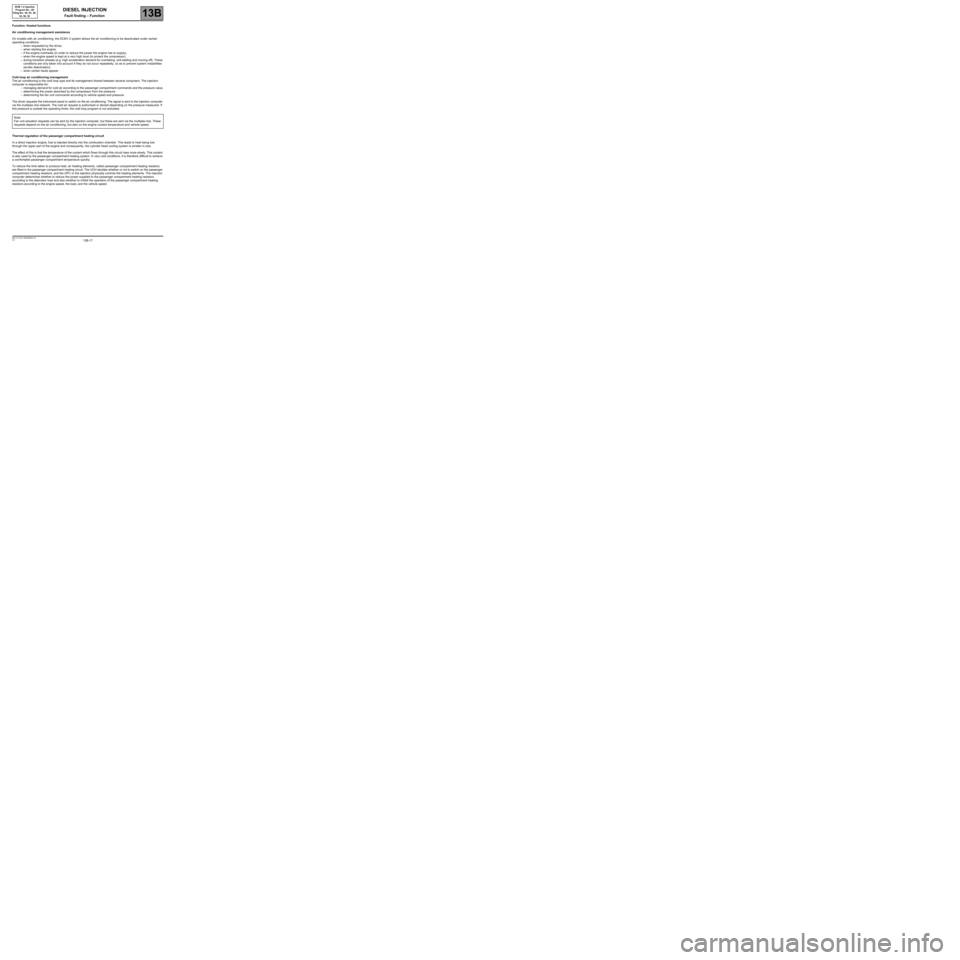
13B-17V6 MR-413-X44-13B000$040.mif
DIESEL INJECTION
Fault finding – Function13B
DCM 1.2 Injection
Program No.: 4D
Vdiag No.: 48, 4C, 50,
54, 58, 5C
Function: Hosted functions
Air conditioning management assistance
On models with air conditioning, the DCM1.2 system allows the air conditioning to be deactivated under certain
operating conditions:
–when requested by the driver,
–when starting the engine,
–if the engine overheats (in order to reduce the power the engine has to supply),
–when the engine speed is kept at a very high level (to protect the compressor),
–during transition phases (e.g. high acceleration demand for overtaking, anti-stalling and moving off). These
conditions are only taken into account if they do not occur repeatedly, so as to prevent system instabilities
(erratic deactivation),
–when certain faults appear.
Cold loop air conditioning management
The air conditioning is the cold loop type and its management shared between several computers. The injection
computer is responsible for:
–managing demand for cold air according to the passenger compartment commands and the pressure value,
–determining the power absorbed by the compressor from the pressure,
–determining the fan unit commands according to vehicle speed and pressure.
The driver requests the instrument panel to switch on the air conditioning. The signal is sent to the injection computer
via the multiplex line network. The cold air request is authorised or denied depending on the pressure measured. If
this pressure is outside the operating limits, the cold loop program is not activated.
Thermal regulation of the passenger compartment heating circuit
In a direct injection engine, fuel is injected directly into the combustion chamber. This leads to heat being lost
through the upper part of the engine and consequently, the cylinder head cooling system is smaller in size.
The effect of this is that the temperature of the coolant which flows through this circuit rises more slowly. This coolant
is also used by the passenger compartment heating system. In very cold conditions, it is therefore difficult to achieve
a comfortable passenger compartment temperature quickly.
To reduce the time taken to produce heat, air heating elements, called passenger compartment heating resistors,
are fitted in the passenger compartment heating circuit. The UCH decides whether or not to switch on the passenger
compartment heating resistors, and the UPC or the injection physically controls the heating elements. The injection
computer determines whether to reduce the power supplied to the passenger compartment heating resistors
according to the alternator load and also whether to inhibit the operation of the passenger compartment heating
resistors according to the engine speed, the load, and the vehicle speed.Note:
Fan unit actuation requests can be sent by the injection computer, but these are sent via the multiplex line. These
requests depend on the air conditioning, but also on the engine coolant temperature and vehicle speed.
Page 106 of 269
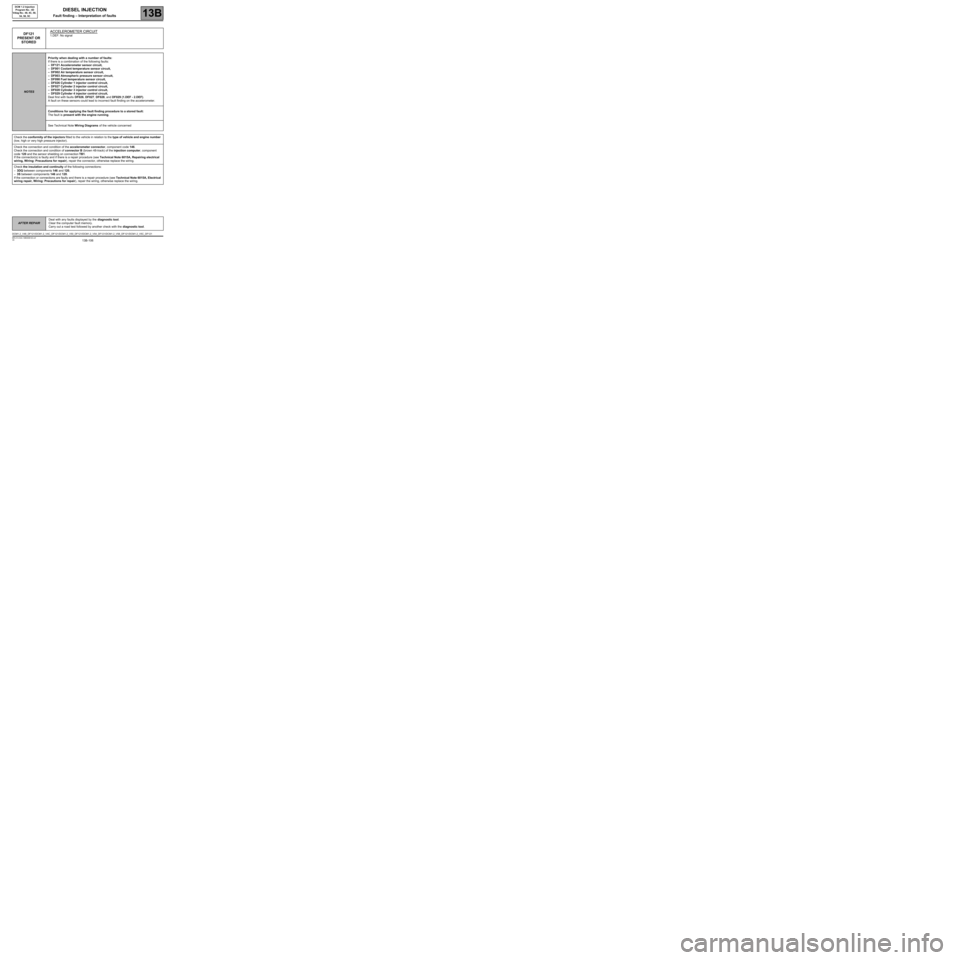
13B-106
AFTER REPAIRDeal with any faults displayed by the diagnostic tool.
Clear the computer fault memory.
Carry out a road test followed by another check with the diagnostic tool.
V6 MR-413-X44-13B000$120.mif
13B
DCM 1.2 Injection
Program No.: 4D
Vdiag No.: 48, 4C, 50,
54, 58, 5C
DF121
PRESENT OR
STOREDACCELEROMETER CIRCUIT1.DEF: No signal
NOTESPriority when dealing with a number of faults:
If there is a combination of the following faults:
–DF121 Accelerometer sensor circuit,
–DF001 Coolant temperature sensor circuit,
–DF002 Air temperature sensor circuit,
–DF003 Atmospheric pressure sensor circuit,
–DF098 Fuel temperature sensor circuit,
–DF026 Cylinder 1 injector control circuit,
–DF027 Cylinder 2 injector control circuit,
–DF028 Cylinder 3 injector control circuit,
–DF029 Cylinder 4 injector control circuit,
Deal first with faults DF026, DF027, DF028, and DF029 (1.DEF - 2.DEF).
A fault on these sensors could lead to incorrect fault finding on the accelerometer.
Conditions for applying the fault finding procedure to a stored fault:
The fault is present with the engine running.
See Technical Note Wiring Diagrams of the vehicle concerned
Check the conformity of the injectors fitted to the vehicle in relation to the type of vehicle and engine number
(low, high or very high pressure injector).
Check the connection and condition of the accelerometer connector, component code 146.
Check the connection and condition of connector B (brown 48-track) of the injection computer, component
code 120 and the sensor shielding on connection TB1.
If the connector(s) is faulty and if there is a repair procedure (see Technical Note 6015A, Repairing electrical
wiring, Wiring: Precautions for repair), repair the connector, otherwise replace the wiring.
Check the insulation and continuity of the following connections:
–3DQ between components 146 and 120,
–3S between components 146 and 120.
If the connection or connections are faulty and there is a repair procedure (see Technical Note 6015A, Electrical
wiring repair, Wiring: Precautions for repair), repair the wiring, otherwise replace the wiring.
DCM1.2_V48_DF121/DCM1.2_V4C_DF121/DCM1.2_V50_DF121/DCM1.2_V54_DF121/DCM1.2_V58_DF121/DCM1.2_V5C_DF121
DIESEL INJECTION
Fault finding – Interpretation of faults
Page 198 of 269
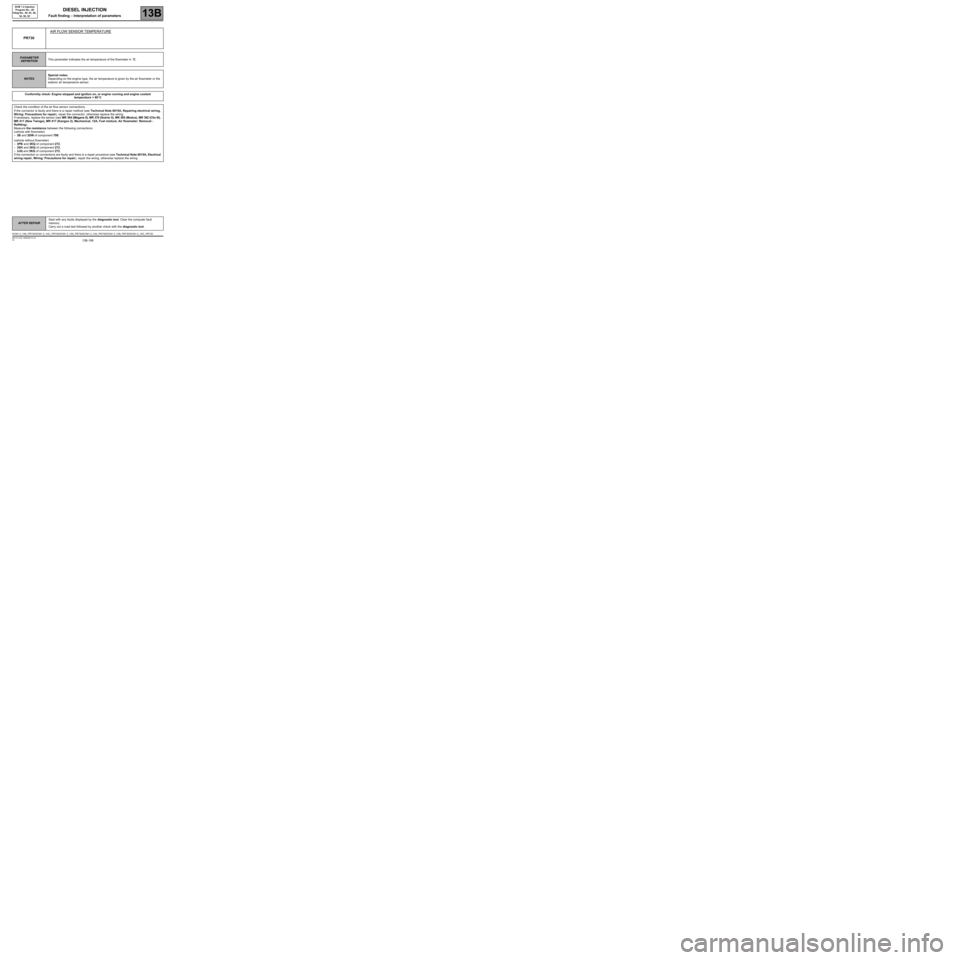
13B-198
AFTER REPAIRDeal with any faults displayed by the diagnostic tool. Clear the computer fault
memory.
Carry out a road test followed by another check with the diagnostic tool.
V6 MR-413-X44-13B000$170.mif
DIESEL INJECTION
Fault finding – Interpretation of parameters13B
DCM 1.2 Injection
Program No.: 4D
Vdiag No.: 48, 4C, 50,
54, 58, 5C
PR730AIR FLOW SENSOR TEMPERATURE
PARAMETER
DEFINITIONThis parameter indicates the air temperature of the flowmeter in °C.
NOTESSpecial notes:
Depending on the engine type, the air temperature is given by the air flowmeter or the
exterior air temperature sensor.
Conformity check: Engine stopped and ignition on, or engine running and engine coolant
temperature > 80
°C
Check the condition of the air flow sensor connections.
If the connector is faulty and there is a repair method (see Technical Note 6015A, Repairing electrical wiring,
Wiring: Precautions for repair), repair the connector, otherwise replace the wiring.
If necessary, replace the sensor (see MR 364 (Mégane II), MR 370 (Scénic II), MR 385 (Modus), MR 392 (Clio III),
MR 411 (New Twingo), MR 417 (Kangoo 2), Mechanical, 12A, Fuel mixture, Air flowmeter: Removal -
Refitting).
Measure the resistance between the following connections:
(vehicle with flowmeter)
–3B and 3DW of component 799;
(vehicle without flowmeter)
–3PB and 3KQ of component 272,
–3SH and 3KQ of component 272,
–3JQ and 3KQ of component 272.
If the connection or connections are faulty and there is a repair procedure (see Technical Note 6015A, Electrical
wiring repair, Wiring: Precautions for repair), repair the wiring, otherwise replace the wiring.
DCM1.2_V48_PR730/DCM1.2_V4C_PR730/DCM1.2_V50_PR730/DCM1.2_V54_PR730/DCM1.2_V58_PR730/DCM1.2_V5C_PR730
Page 216 of 269
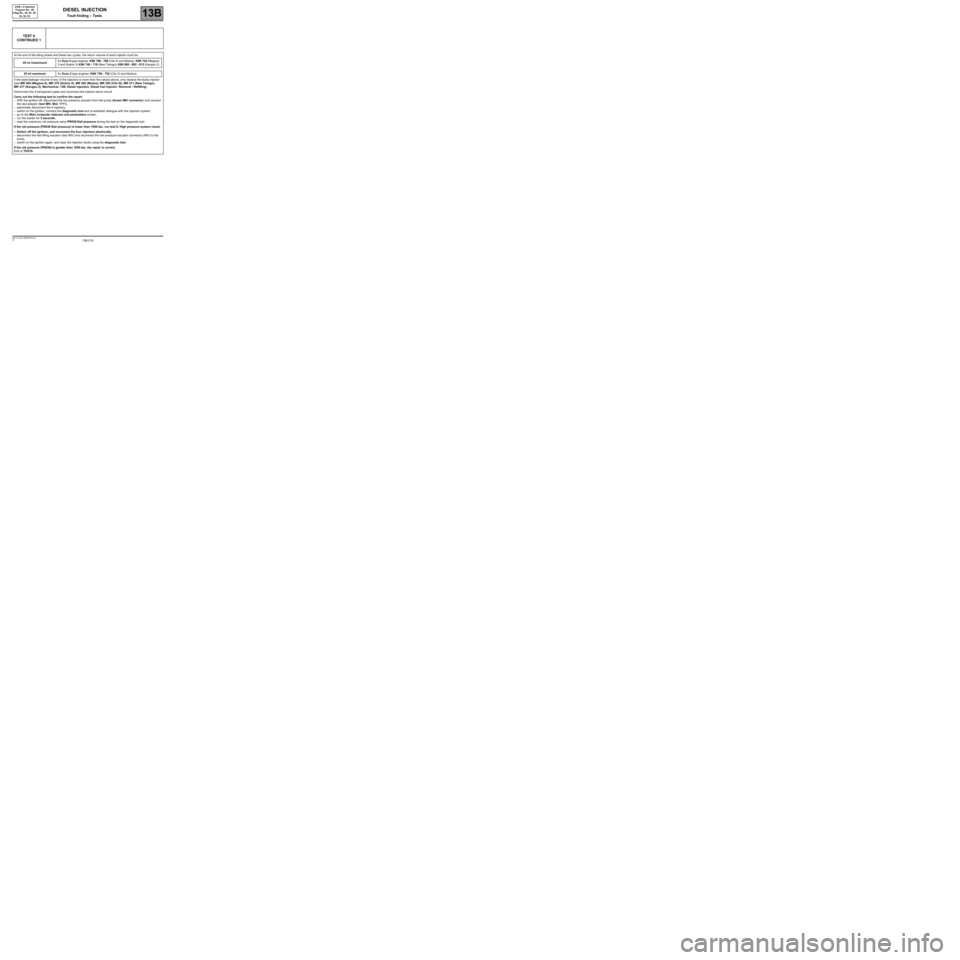
13B-216V6 MR-413-X44-13B000$190.mif
DIESEL INJECTION
Fault finding – Tests13B
DCM 1.2 Injection
Program No.: 4D
Vdiag No.: 48, 4C, 50,
54, 58, 5C
TEST 8
CONTINUED 1
At the end of the idling phase and these two cycles, the return volume of each injector must be:
45 ml (maximum)for Euro 4 type engines: K9K 766 - 768 (Clio III and Modus); K9K 724 (Mégane
II and Scénic II) K9K 740 - 718 (New Twingo); K9K 800 - 802 - 812 (Kangoo 2).
35 ml maximumfor Euro 3 type engines: K9K 750 - 752 (Clio III and Modus),
If the back-leakage volume of any of the injectors is more than the values above, only replace the faulty injector
(see MR 364 (Mégane II), MR 370 (Scénic II), MR 385 (Modus), MR 392 (Clio III), MR 411 (New Twingo),
MR 417 (Kangoo 2), Mechanical, 13B, Diesel injection, Diesel fuel injector: Removal - Refitting).
Disconnect the 4 transparent pipes and reconnect the injector return circuit.
Carry out the following test to confirm the repair:
–With the ignition off, disconnect the low pressure actuator from the pump (brown IMV connector) and connect
the test adapter (test IMV, Mot. 1711),
–electrically disconnect the 4 injectors,
–switch on the ignition, connect the diagnostic tool and re-establish dialogue with the injection system,
–go to the Main computer statuses and parameters screen,
–run the starter for 5 seconds,
–read the maximum rail pressure value PR038 Rail pressure during the test on the diagnostic tool.
If the rail pressure (PR038 Rail pressure) is lower than 1050 bar, run test 6: High pressure system check.
–Switch off the ignition, and reconnect the four injectors electrically,
–disconnect the test filling actuator (test IMV) and reconnect the low-pressure actuator connector (IMV) to the
pump,
–switch on the ignition again, and clear the injection faults using the diagnostic tool.
If the rail pressure (PR038) is greater than 1050 bar, the repair is correct.
End of TEST8.
Page 223 of 269

13B-223V6 MR-413-X44-13B000$190.mif
DIESEL INJECTION
Fault finding – Tests13B
DCM 1.2 Injection
Program No.: 4D
Vdiag No.: 48, 4C, 50,
54, 58, 5C
TEST 11 Air line at the turbocharger
Check that the air filter is present.
Check the replacement interval of the air filter on the maintenance booklet.
Compare the part nos. of the fitted air filter on the vehicle and of the air filter recommended by the manufacturer.
Check the direction of fitting of the air filter.
Is the air filter correctly fitted on the vehicle?
Check the condition of the air filter
Visually inspect the condition of the filtering section of the air
filter.
Is the air filter or its seal damaged?
Is the air filter fouled (does it contain a lot of impurities)?Replace the air filter (see MR 364
(Mégane II), 370 (Scénic II), 392
(Clio III), 385 (Modus), 411
(New Twingo) or 417 (Kangoo II)
Mechanical, 12A, Fuel mixture,
Air filter, Removal - Refitting).
Low pressure circuit check
Note:
Depending on the vehicle type, the best visual access will be
either from above or from below.
Visually inspect the condition of the following components:
–fresh air inlet scoop on the front panel of the vehicle,
–air inlet pipe to the air filter,
–air pipe of the filter up to the compressor inlet,
–air flowmeter mountings.
Is one of these components incorrect (pipes dislodged,
torn, bent, pierced or kinked)?Replace the faulty parts (see MR
364 (Mégane II), 370 (Scénic II)
392 (Clio III), 385 (Modus), 411
(New Twingo) or 417 (Kangoo II),
Mechanical, 12B,
Turbocharging).
YESNO
YES
NO
YES
NO
A
DCM1.2_V48_TEST11/DCM1.2_V4C_TEST11/DCM1.2_V50_TEST11/DCM1.2_V54_TEST11/DCM1.2_V58_TEST11/DCM1.2_V5C_TEST11
Page 230 of 269
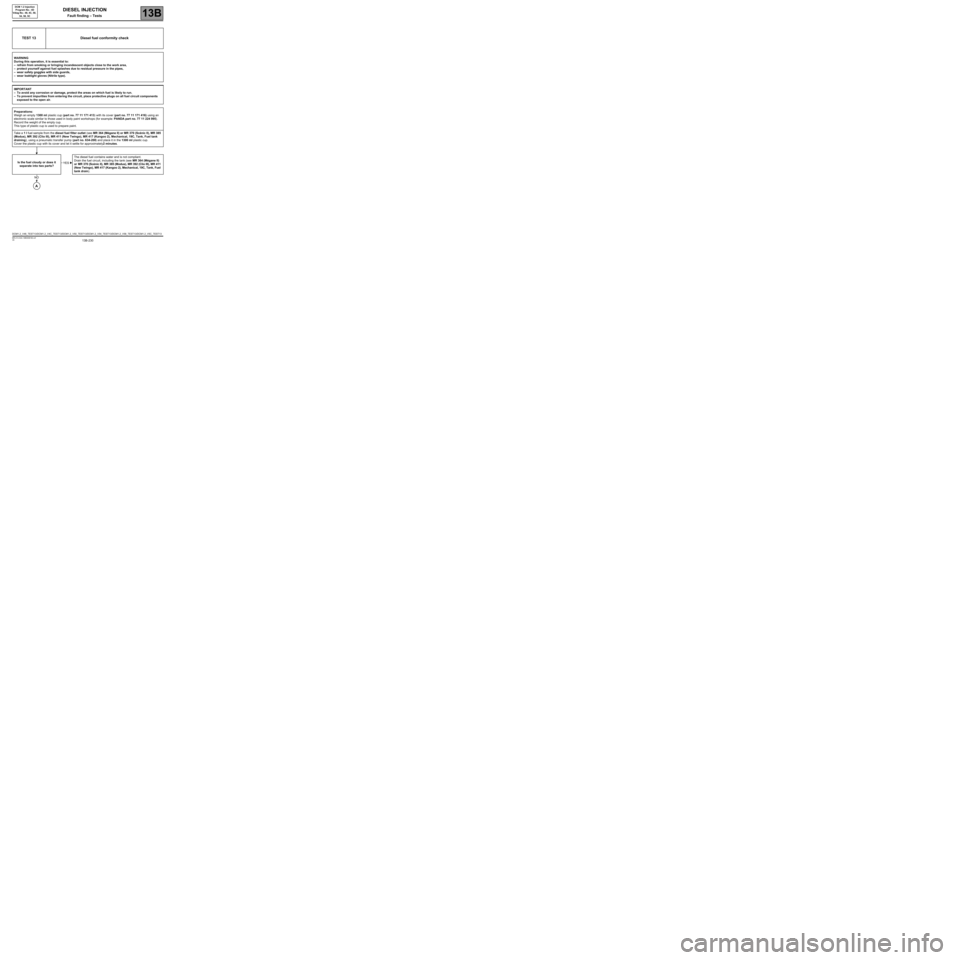
13B-230V6 MR-413-X44-13B000$190.mif
DIESEL INJECTION
Fault finding – Tests13B
DCM 1.2 Injection
Program No.: 4D
Vdiag No.: 48, 4C, 50,
54, 58, 5C
TEST 13 Diesel fuel conformity check
WARNING
During this operation, it is essential to:
–refrain from smoking or bringing incandescent objects close to the work area,
–protect yourself against fuel splashes due to residual pressure in the pipes,
–wear safety goggles with side guards,
–wear leaktight gloves (Nitrile type).
IMPORTANT
–To avoid any corrosion or damage, protect the areas on which fuel is likely to run.
–To prevent impurities from entering the circuit, place protective plugs on all fuel circuit components
exposed to the open air.
Preparations:
Weigh an empty 1300 ml plastic cup (part no. 77 11 171 413) with its cover (part no. 77 11 171 416) using an
electronic scale similar to those used in body paint workshops (for example: PANDA part no. 77 11 224 995).
Record the weight of the empty cup.
This type of plastic cup is used to prepare paint.
Take a 1 l fuel sample from the diesel fuel filter outlet (see MR 364 (Mégane II) or MR 370 (Scénic II), MR 385
(Modus), MR 392 (Clio III), MR 411 (New Twingo), MR 417 (Kangoo 2), Mechanical, 19C, Tank, Fuel tank
draining), using a pneumatic transfer pump (part no. 634-200) and place it in the 1300 ml plastic cup.
Cover the plastic cup with its cover and let it settle for approximately2 minutes.
Is the fuel cloudy or does it
separate into two parts?The diesel fuel contains water and is not compliant.
Drain the fuel circuit, including the tank (see MR 364 (Mégane II)
or MR 370 (Scénic II), MR 385 (Modus), MR 392 (Clio III), MR 411
(New Twingo), MR 417 (Kangoo 2), Mechanical, 19C, Tank, Fuel
tank drain).
YES
NO
A
DCM1.2_V48_TEST13/DCM1.2_V4C_TEST13/DCM1.2_V50_TEST13/DCM1.2_V54_TEST13/DCM1.2_V58_TEST13/DCM1.2_V5C_TEST13
Page 268 of 269

13B-268V6 MR-413-X44-13B000$210.mif
DIESEL INJECTION
Fault finding – Fault finding charts13B
DCM 1.2 Injection
Program No.: 4D
Vdiag No.: 48, 4C, 50,
54, 58, 5C
ALP18 Oil leaks from the turbocharger
NOTESBefore dealing with this customer complaint, check that there are no faults,
and the conformity (or otherwise) of the parameters and statuses using
the diagnostic tool.
If the customer complaint is not eliminated, perform the following checks.
Check the area around the turbocharger
Note:
An oil leak does not correspond always to a turbocharger fault, the oil leak can arise from the area around
the turbocharger.
Depending on the vehicle type, the best visual access will be either from above or from below.
1. Do not start the engine.
Check the area around the turbocharger and identify the origin of the leaks.
Clean the oil traces on the turbocharger.
2. Start the engine and let it warm up several minutes.
IMPORTANT
If the air filter was removed previously, refit it before starting the engine (risks foreign matter entering the air inlet
circuit).
Accelerate with no load several times, progressively increasing the duration before releasing the accelerator pedal.
Visually inspect the exterior condition of the fuel supply pipes and the turbocharger oil return and the area around it.
Identify the origin of the leaks.
Is an oil leak present at the air compressor inlet or outlet?
Check the air compressor inlet or outlet
Check for a loose interface (inlet or outlet) that is the cause of the air leak.
Note:
It is normal to find oil traces inside the pipes at the turbocharger inlet or outlet,
because the air entering the compressor is laden with oil from the engine
rebreathing circuit.
Is the suspected interface properly tightened?Tighten the interface
or the concerned pipe.
End of procedure.
Replace the pipe concerned (see MR 364 (Mégane II), 370 (Scénic II), 392 (Clio III), 385 (Modus), 411
(New Twingo), or 417 (Kangoo II), Mechanical, 12B Turbocharging).
YES
NO
A
NO
YES
DCM1.2_V48_ALP18/DCM1.2_V4C_ALP18/DCM1.2_V50_ALP18/DCM1.2_V54_ALP18/DCM1.2_V58_ALP18/DCM1.2_V5C_ALP18